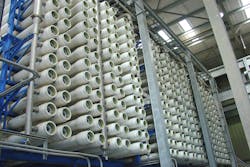As the global economy continues to move toward a low-carbon energy infrastructure, the lithium industry is going through its own transition to meet the demand for lithium-ion batteries. Per the Center on Global Energy Policy, lithium demand tripled from 2017 to 2023, and will grow tenfold by 2050 under the International Energy Agency’s (IEA) Net Zero Emissions by 2050 Scenario. To meet future demand, sustainable and efficient methods of extracting and refining lithium from brine are crucial.
Over the last five years, lithium production has been primarily sourced from hard rock mining and brine water processing. Conventional methods of extracting lithium from brine rely on evaporation ponds to increase lithium concentration, followed by purification and conversion processes to crystallize lithium carbonate. However, these conventional methods have several inefficiencies that make it difficult to increase lithium production sustainably due to chemical intensity, the requirement of a large footprint, extended processing times and lower lithium yield (often only 50%).
Direct lithium extraction (DLE) technology has emerged as a promising alternative to overcome these inefficiencies. According to Goldman Sachs, DLE stands to nearly double lithium production — it replaces evaporation ponds, creating the potential to expand lithium extraction from more sources and improves yield from approximately 50% to upwards of 95%. Adoption of DLE over conventional methods also alleviates local concerns of water loss in arid regions. The three main DLE methods are adsorption, ion exchange and solvent extraction. Each method provides advantages based on multiple factors, including the chemistry of the raw brine and availability of freshwater used in the elution of lithium from the DLE media. Several companies are piloting DLE technologies in South America, North America and Europe. In the United States, DLE demonstration plants are undergoing trials in Arkansas and California, with potential future trials in Utah.
Similar to all lithium refining processes, DLE requires additional process steps downstream to further purify the DLE eluted brine, increase its concentration and convert the lithium from the aqueous brine solution (typically lithium chloride) to the desired end-product, either lithium carbonate or lithium hydroxide monohydrate. When developing a lithium flowsheet solution from DLE aqueous brine to end-product, new technology options can further improve lithium yield, reduce production cost and simplify process steps to achieve the desired end-product quality. Technology selection can also improve sustainability by reducing chemical usage, waste disposal and energy consumption. Let’s dig deeper into some of these options for flowsheet optimization.
Brine purification
Softening the brine is critical in the lithium refining process to ensure the end-product quality is free of divalent ions such as calcium, magnesium and sulfates. Softening the brine toward the front end of the flowsheet also maximizes the effectiveness of reverse osmosis (RO) technology to concentrate the brine.
When considering technology options for softening, nanofiltration (NF) can be an effective choice for reducing chemical and waste disposal costs compared to using only physical-chemical processes. NF allows monovalent ions, including lithium, to pass through into the permeate while rejecting 80-95% of calcium, magnesium and sulfate ions. Although a small amount of lithium remains in the NF reject stream, it can potentially be recovered by reprocessing the reject stream through the DLE system. To evaluate the economic benefits of NF, it is important to consider the additional costs of softening to remove metals such as aluminum and iron, as well as polishing steps to remove residual hardness post-NF.
In some cases, ultrafiltration (UF) or physical-chemical processes are added steps to pretreat the brine before DLE. This pretreatment step helps remove suspended solids and other impurities, ensuring a cleaner feed for the DLE process and potentially extending the life of the DLE media or membranes.
Brine concentration
After softening, the brine may have a dissolved solids concentration of 10-20 grams per liter (g/L), with lithium accounting for approximately 1-2 g/L within the aqueous brine solution.
If the DLE system effectively minimizes the migration of silica into the post-DLE aqueous brine solution, RO can concentrate the brine up to the osmotic pressure limit. Emerging RO technologies, such as ultrahigh-pressure RO and osmotically assisted RO, can double or triple the concentration of conventional seawater RO. Utilizing these advanced RO technologies to achieve higher concentration endpoints can significantly reduce sizing for downstream thermal brine concentration, which reduces energy entitlements by up to 70% compared to conventional thermal technologies.
However, if the DLE system does not effectively separate out silica, higher levels of silica in the post-DLE eluted brine may limit RO brine concentration. Adding caustic to increase the pH is an option to keep silica soluble, but the additional chemical cost may outweigh the energy savings of using RO instead of thermal brine concentration, especially in remote areas where chemicals would need to be transported over long distances. In lithium processing, antiscalants are typically avoided, as they may inhibit downstream crystallization of the lithium carbonate.
Another factor that may limit RO brine concentration is biofouling. Proper pretreatment and monitoring of the RO system are essential to mitigate this issue and ensure optimal performance.
Lithium conversion for lithium carbonate
The next stage in the lithium refining process occurs after almost all impurities have been removed from the aqueous brine solution and the dissolved lithium concentration has been concentrated 20 times or more.
In the conversion stage, the lithium in aqueous solution is typically converted to a lithium carbonate (Li2CO3) or lithium hydroxide monohydrate (LiOH*H2O) end-product. The market demand for lithium carbonate and lithium hydroxide monohydrate is mainly driven by the growing production of specific lithium-ion battery chemistries. There are three predominant lithium-ion battery chemistries: lithium iron phosphate (LFP), lithium nickel manganese cobalt oxide (NMC) and lithium nickel cobalt aluminum oxide (NCA).
LFP batteries have lower production costs and typically use lithium carbonate as the precursor in the cathode synthesis process. To crystallize Li2CO3 from lithium chloride brines, the conventional method is a multi-step physical-chemical process involving the addition of sodium carbonate (Na2CO3). In this process, the sodium ions free up the lithium ions to bond with the carbonate ions, causing Li2CO3 to crystallize. The Li2CO3 crystals are then separated from the mother liquor and may undergo further dissolution and recrystallization steps to meet the stringent battery-grade quality requirements, which often stipulate impurity levels below 50 parts per million (ppm) for elements such as sodium.
Lithium conversion for lithium hydroxide monohydrate
While LFP batteries offer a cost advantage compared to the production cost of NMC or NCA batteries, nickel-cobalt chemistries have the desired advantage of having a higher energy density compared to LFP batteries.
Nickel-cobalt battery chemistries are preferred when minimizing mobile device weight or maximizing electric vehicle range is a priority. Historically, EVs with a range exceeding 300 miles have used batteries with NMC or NCA chemistries. In the manufacturing process of the cathode, the physical properties of lithium hydroxide allow for rapid and complete cathode synthesis at a lower temperature, which results in extending battery life verses needing to complete the synthesis of the cathode at a higher temperature when using lithium carbonate as the precursor.
The conventional process to crystallize lithium hydroxide monohydrate (LHM) from lithium chloride aqueous brine involves a two-step conversion process. The first step is to produce a crude lithium carbonate, followed by a second step where a hydroxide (usually calcium hydroxide) is added to create a lithium hydroxide aqueous solution. This aqueous solution is then concentrated by a thermal evaporator followed by a forced circulation crystallizer to precipitate LHM. The conventional process steps to crystallize LHM are both chemically and energy intensive.
To simplify the flowsheet to crystallize LHM from lithium chloride brines, Veolia is developing a new direct conversion process to eliminate the need to first produce lithium carbonate. In this new method, a continuous ion exchange process directly converts lithium chloride to lithium hydroxide by using sodium hydroxide as the reagent for conversion. This results in a simpler flowsheet to produce LHM, while also reducing chemical usage, waste generation and energy consumption. Although this new direct lithium conversion method is still in the development stage, this technology, combined with DLE, has the potential to significantly reduce both the cost and environmental footprint of producing LHM for nickel-cobalt battery chemistries.
As the demand for lithium-ion batteries continues to grow, the lithium refining industry is looking to improve processing methods to minimize environmental impact and meet sustainability goals. To produce lithium carbonate or lithium hydroxide monohydrate end-products from brine, the implementation of DLE flowsheets adopting technologies such as NF, advanced RO and direct lithium hydroxide conversion methods are helping the lithium industry to reduce chemical usage, waste generation and energy consumption. The path ahead is clear: Through innovation, optimization and a steadfast commitment to sustainability, the lithium industry can meet the demands of a transitioning energy future striving to be cleaner and greener.
About the Author
Josh Dewanaga
Senior product manager for Veolia Water Technologies & Solutions
Josh Dewanaga is a senior product manager for Veolia Water Technologies & Solutions focusing on brine concentration and crystallization applications. During his 15 years in industrial water and wastewater treatment, he has worked on various integrated projects around the globe and has served as a technical leader for the design of evaporator and crystallizer systems. His experience also extends to leading the development of new brine concentration solutions to best meet the business and environmental needs of customers

